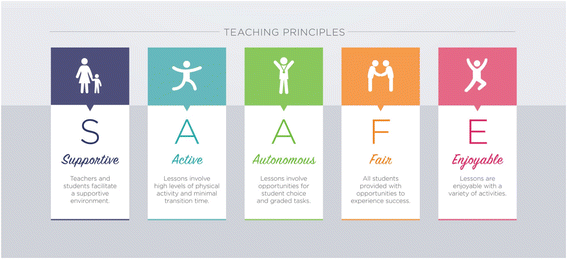Framework for the design and delivery of organized physical activity sessions for children and adolescents: rationale and description of the 'SAAFE' teaching principles
- PMID: 28231794
- PMCID: PMC5324233
- DOI: 10.1186/s12966-017-0479-x
Framework for the design and delivery of organized physical activity sessions for children and adolescents: rationale and description of the 'SAAFE' teaching principles
Abstract
The economic burden of inactivity is substantial, with conservative estimates suggesting the global cost to health care systems is more than US$50 billion. School-based programs, including physical education and school sport, have been recommended as important components of a multi-sector, multi-system approach to address physical inactivity. Additionally, community sporting clubs and after-school programs (ASPs) offer further opportunities for young people to be physically active outside of school. Despite demonstrating promise, current evidence suggests school-based physical activity programs, community sporting clubs and ASPs are not achieving their full potential. For example, physical activity levels in physical education (PE) and ASP sessions are typically much lower than recommended. For these sessions to have the strongest effects on young people's physical activity levels and their on-going physical literacy, they need to improve in quality and should be highly active and engaging. This paper presents the Supportive, Active, Autonomous, Fair, Enjoyable (SAAFE) principles, which represent an evidence-based framework designed to guide the planning, delivery and evaluation of organized physical activity sessions in school, community sport and ASPs. In this paper we provide a narrative and integrative review of the conceptual and empirical bases that underpin this framework and highlight implications for knowledge translation and application.
Keywords: Coaching; Enjoyment; Fitness; Motivation; Physical education; Self-determination theory; Teaching.
Figures
Similar articles
-
Effects of a School-Based Intervention on Motivation for Out-of-School Physical Activity Participation.Res Q Exerc Sport. 2021 Sep;92(3):477-491. doi: 10.1080/02701367.2020.1751029. Epub 2020 Jul 9. Res Q Exerc Sport. 2021. PMID: 32643561
-
The post 16 gap: how do young people conceptualise PE? An exploration of the barriers to participation in physical education, physical activity and sport in senior school pupils.Int J Adolesc Med Health. 2021 Jun 30;33(6):313-321. doi: 10.1515/ijamh-2021-0003. Int J Adolesc Med Health. 2021. PMID: 34187138 Review.
-
Increasing girls' physical activity during an organised youth sport basketball program: a randomised controlled trial protocol.BMC Public Health. 2014 Apr 21;14:383. doi: 10.1186/1471-2458-14-383. BMC Public Health. 2014. PMID: 24751173 Free PMC article. Clinical Trial.
-
An Internet-supported Physical Activity Intervention Delivered in Secondary Schools Located in Low Socio-economic Status Communities: Study Protocol for the Activity and Motivation in Physical Education (AMPED) Cluster Randomized Controlled Trial.BMC Public Health. 2016 Jan 6;16:17. doi: 10.1186/s12889-015-2583-7. BMC Public Health. 2016. PMID: 26740092 Free PMC article. Clinical Trial.
-
Youth resistance training: updated position statement paper from the national strength and conditioning association.J Strength Cond Res. 2009 Aug;23(5 Suppl):S60-79. doi: 10.1519/JSC.0b013e31819df407. J Strength Cond Res. 2009. PMID: 19620931 Review.
Cited by
-
Associations between Feelings of Loneliness and Attitudes towards Physical Education in Contemporary Adolescents According to Sex, and Physical Activity Engagement.Int J Environ Res Public Health. 2020 Jul 30;17(15):5525. doi: 10.3390/ijerph17155525. Int J Environ Res Public Health. 2020. PMID: 32751756 Free PMC article.
-
Just Sit Still and Pay Attention?-A Commentary.J Sch Health. 2020 May;90(5):345-348. doi: 10.1111/josh.12881. Epub 2020 Feb 23. J Sch Health. 2020. PMID: 32090343 Free PMC article. No abstract available.
-
Effects of a school-based physical activity intervention on children with intellectual disability: a cluster randomized trial.Int J Behav Nutr Phys Act. 2025 Jul 25;22(1):103. doi: 10.1186/s12966-025-01798-5. Int J Behav Nutr Phys Act. 2025. PMID: 40713715 Free PMC article. Clinical Trial.
-
A systems thinking framework for understanding rising childhood obesity in the Caribbean.Health Res Policy Syst. 2024 Aug 21;22(1):115. doi: 10.1186/s12961-024-01201-y. Health Res Policy Syst. 2024. PMID: 39169406 Free PMC article.
-
Associations of sport participation with subjective well-being: a study consisting of a sample of Chinese school-attending students.Front Public Health. 2023 Jun 23;11:1199782. doi: 10.3389/fpubh.2023.1199782. eCollection 2023. Front Public Health. 2023. PMID: 37427269 Free PMC article.
References
-
- Rangul V, Bauman A, Holmen TL, Midthjell K. Is physical activity maintenance from adolescence to young adulthood associated with reduced CVD risk factors, improved mental health and satisfaction with life: the HUNT Study, Norway. Int J Behav Nutr Phys Act. 2012;9:144. doi: 10.1186/1479-5868-9-144. - DOI - PMC - PubMed
Publication types
MeSH terms
LinkOut - more resources
Full Text Sources
Other Literature Sources
Medical


